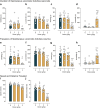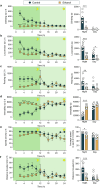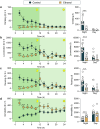Automated home-cage-like monitoring for assessing innate behaviors in a murine hangover model
- PMID: 40796579
- PMCID: PMC12343899
- DOI: 10.1038/s41598-025-13334-3
Automated home-cage-like monitoring for assessing innate behaviors in a murine hangover model
Abstract
The prevalence of alcohol consumption among the younger generation remains alarmingly high. A hangover is a common short-term consequence observed after consuming alcohol. To effectively study alcohol-induced hangovers, reliable and translational animal models, along with appropriate testing methods, are required. While several testing approaches have been used in hangover-induced mice, they often fail to assess innate behaviors comprehensively and are limited by short observation periods. Although existing studies have developed methods to assess hangover-related behaviors in rodents, few have focused on innate behaviors. This study aimed to establish a model for assessing the innate behaviors of hangover-induced mice using automated home-cage-like behavioral monitoring. Mice were intraperitoneally injected with ethanol at doses of 3, 2, or 1 g/kg, followed by behavioral assessments, including exploratory actions and long-term home-cage-like behaviors during both day and night phases. Results showed a significant reduction in mobile behaviors (climbing, locomotion, rearing), speed, and distance traveled, along with increased immobility in both exploratory and long-term home-cage-like assessments. Furthermore, there was a significant decrease in exploratory behaviors and long-term home-cage-like activities, which were linked to hangover symptoms. This study provides a preliminary approach for assessing hangover behaviors in mice using automated behavioral monitoring, ensuring improved animal welfare, optimised timing, and extended assessment durations. Hence, we propose automated home-cage-like behavioral assessment as an exploratory model for evaluating hangover behaviors in mice, which may serve as a useful tool for future research on the therapeutic efficacy of anti-hangover compounds.
Keywords: Automated home-cage-like monitoring; Ethanol; Exploratory behaviors; Hangover; Long-term locomotor behaviors; Motor coordination.
© 2025. The Author(s).
Conflict of interest statement
Declarations. Competing interests: The authors declare no competing interests.
Figures







Similar articles
-
Prescription of Controlled Substances: Benefits and Risks.2025 Jul 6. In: StatPearls [Internet]. Treasure Island (FL): StatPearls Publishing; 2025 Jan–. 2025 Jul 6. In: StatPearls [Internet]. Treasure Island (FL): StatPearls Publishing; 2025 Jan–. PMID: 30726003 Free Books & Documents.
-
The Black Book of Psychotropic Dosing and Monitoring.Psychopharmacol Bull. 2024 Jul 8;54(3):8-59. Psychopharmacol Bull. 2024. PMID: 38993656 Free PMC article. Review.
-
The quantity, quality and findings of network meta-analyses evaluating the effectiveness of GLP-1 RAs for weight loss: a scoping review.Health Technol Assess. 2025 Jun 25:1-73. doi: 10.3310/SKHT8119. Online ahead of print. Health Technol Assess. 2025. PMID: 40580049 Free PMC article.
-
Falls prevention interventions for community-dwelling older adults: systematic review and meta-analysis of benefits, harms, and patient values and preferences.Syst Rev. 2024 Nov 26;13(1):289. doi: 10.1186/s13643-024-02681-3. Syst Rev. 2024. PMID: 39593159 Free PMC article.
-
Systemic pharmacological treatments for chronic plaque psoriasis: a network meta-analysis.Cochrane Database Syst Rev. 2021 Apr 19;4(4):CD011535. doi: 10.1002/14651858.CD011535.pub4. Cochrane Database Syst Rev. 2021. Update in: Cochrane Database Syst Rev. 2022 May 23;5:CD011535. doi: 10.1002/14651858.CD011535.pub5. PMID: 33871055 Free PMC article. Updated.
References
-
- Organization, W. H. Global status report on alcohol and health and treatment of substance use disorders. Geneva World Heal Organ (2024).
-
- Organization, W. H. Global Status Report on Alcohol and Health 2018 (World Health Organization, 2018).
-
- Hendriks, H. F. J. Alcohol and human health: what is the evidence?? Annu. Rev. Food Sci. Technol.11, 1–21 (2020). - PubMed
-
- Palmer, E. et al. Alcohol hangover: underlying biochemical, inflammatory and neurochemical mechanisms. Alcohol. Alcohol.54, 196–203 (2019). - PubMed
-
- Karadayian, A. G. et al. Alcohol hangover induces mitochondrial dysfunction and free radical production in mouse cerebellum. Neuroscience304, 47–59 (2015). - PubMed
Grants and funding
LinkOut - more resources
Full Text Sources

